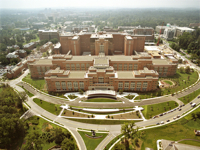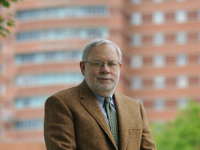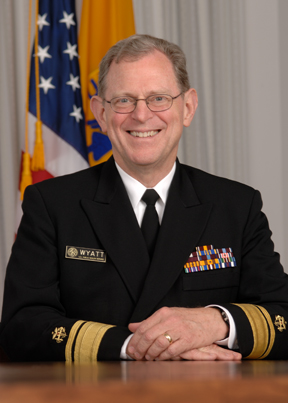 |
 |
 |
||
The NIH Clinical Center |
Alan Schechter |
Minkyung (Min) Song |
| TH E N I H C A T A L Y S T | JU L Y – A U G U S T 2008 |
| | |
Translational research, with its mantra "bench to bedside and back," emerged as a top priority for the NIH intramural program in 2003, coupled with the new NIH Roadmap targeting the reemergence of clinical research as a major goal. The call was for focused communication between the laboratory and clinic to translate basic biomedical research into effective new therapies — and to bring clinical observations back to the lab.
The topic remains a hot one, featured on the cover of Nature on June 12, 2008, with an editorial and several news stories prominently featuring opinions about what the NIH is and isn't doing.
But the concept of "translational research" isn't so innovative or radical, says Alan Schechter, chief of NIDDK's Molecular Medicine Branch, one of NIH's most vocal proponents of translational research. The combination of basic and clinical research has been at the heart of the NIH mission since before the Clinical Center was in its blueprint phase.
What has happened along the way, Schechter said, is the vast success of basic research — spurred, in part, by the genetics revolution, bioinformatics and other lab techniques — which has lured many a promising scientist and physician to a life at the bench. The NIH has been a victim of its own success, too, now competing among the numerous research institutions that NIH helped to create for an ever-shrinking, highly qualified pool of scientists, especially physician-scientists, willing to undertake translational research.
As a result, despite the presence of the NIH Clinical Center — the largest hospital in the world dedicated to clinical research, purposefully placed at the geographic heart of the Bethesda campus — the NIH is having difficulty maintaining its prominence in the realm of translational research.
So what's a successful research institution to do? Essentially the NIH hopes to generate mechanisms to do more with what it has, to create ways to streamline the translation of benchwork into medical practice, all the while continuing efforts to recruit clinical investigators and to fill the Clinical Center to its capacity with patients.
Key to this will be removing the barriers to clinical research, both at an institutional and investigator level. And in the process of self-analysis, even the wording of "bench to bedside" is under scrutiny, for clinical research starts with patients, which feeds bench work. There's no hierarchy; all researchers are equal players in the endeavor to make patients well. This concept must be inherent in any translational research program to recruit researchers, said those interviewed for this article.
The effort may serve as a model for other biomedical research facilities also faced with a changing landscape of clinical research.
 |
 |
 |
||
The NIH Clinical Center |
Alan Schechter |
Minkyung (Min) Song |
Translational roadblocks
The loss of focus on translational research is no trivial matter. "Many in Congress and the public believe that NIH is not delivering new therapies to a degree consistent with the money going in," Schechter said. Whether that's true or not, he added, an effective way to produce new therapies is through translational research, which, when you get right down to it, "is a synonym for clinical research," he said.
On the surface, translational research is straightforward: Scientists work on a treatment at the bench; clinicians test it at the patient's bedside; and observations of patients go back to the lab to inform further research. But the devil's in the details.
Cliff Lane, NIAID's clinical director, is leading an Intramural Working Group subcommittee, comprising the entire Medical Executive Committee, investigating these details. The initial findings from the group are expected by summer's end. Lane said there is a "sentiment... [among NIH researchers] that it is increasingly difficult to do clinical studies," and that his group was identifying elements that "provide less 'value-added' than desired."
In meeting with patients and doctors in recent months, the subcommittee has focused on four elements for initial study: issues concerning the availability of resources, the scientific review process, the institutional review board, and technology transfer. The subcommittee's initial recommendations will focus on improvement to the IRB process.
Clinical Center Director John Gallin added two more elements that PIs often relay to him: conflict-of-interest issues and a comparatively low salary cap for "hot shot" physicians expert in medical subspecialties.
But turning basic research into applicable therapies is very much feasible, said Minkyung Song, program director at NCI's Developmental Therapeutics Program and co-founder of NIH's Translational Research Interest Group (TRIG). Strategies for addressing clinical relevance of model systems are becoming available, and high-quality human specimens are easier to attain.
Transition, by the numbers
Faced with obstacles, and enticed by advances in basic research, scientists have gravitated to the bench. Since the 1970s, the number of clinical investigators at NIH and across the country has steadily dwindled while the total number of researchers has grown.
There were 14,479 U.S.-based physician-scientists in 1998, down from 18,535 in 1983, a 22-percent decline, according to a 2002 article in Nature by Ajit Varki and Leon Rosenberg, "Emerging opportunities and career paths for the young physician-scientist." Also, the percentage of physicians engaged in research shrank from 4.6 percent in 1985 to 1.8 percent in 2003, according to a 2005 article in JAMA by Timothy Ley and Rosenberg, "The Physician-Scientist Career Pipeline in 2005."
Rosenberg, of Princeton University, documented that the number of NIH research project grants awarded to PhDs, to MDs and to MD/PhDs in 1970 were somewhat comparable: 2,000 (53% of the total) and 1,200 (43%), respectively. This changed markedly by 1997: 5,200 (~70%) and 2,100 (25%), respectively. These figures are from a 1999 article in the Journal of Clinical Investigation, "The physician-scientist: An essential — and fragile — link in the medical research chain."
Closer to home, since 2001, as the number of tenured investigators at the NIH climbed from 907 to 943, the number of tenured PIs on clinical protocols decreased from 192 to 156, according to data compiled by the Clinical Center's Office of Protocol Services. Similarly, the number of tenure track PIs listed on clinical protocols has fallen from 48 to 18. One highlight, however, is the increase in individual principal investigators writing clinical protocols: 461 investigators in 2001, and 547 in 2007, reflecting an increase in the number of staff clinicians writing protocols.
No lab is an island
In order to make more effective use of the successes of basic research, NIH has to encourage scientists to move laboratory discoveries into the clinic more quickly, and to translate clinical research data back to the laboratory, said Song.
To accommodate this, Song helped create the TRIG in 2007. The TRIG fosters communication between basic and clinical scientists across disciplines and guides the training of a new generation of translational researchers. This scientist-run group aims to accelerate application of research discoveries towards proof-of-concept clinical studies and the development of personalized treatments, predictive or monitoring tools, improved models, and safer and more effective therapeutics through the strengthening of communication networks within NIH.
Working in a lab shouldn't feel like living on an island, said Song. The establishment of forums for sharing resources, tools and information is the most important thing NIH can do to promote translational research. "It's timely to integrate and coordinate efforts in both the intramural and extramural programs," Song said. "As early as possible, we need to confirm laboratory results in real human specimens."
 |
 |
|
CC Director John Gallin |
OIR Deputy Director Richard Wyatt |
New and ongoing efforts
The TRIG's first major event was in May and exceeded expectations with a large turnout of about 100 researchers at Natcher for what was a two-hour huddle on the status and necessary future course of translational research at NIH. Cutting to the chase, OIR Deputy Director Richard Wyatt opened the meeting with a talk provocatively titled "Challenges of Translational Research at the NIH."
A top challenge is to fill the Clinical Research Center with outstanding science projects; it is now running at about two-thirds its capacity, Wyatt said. Steering clear of mandates — just two additional physician-scientists for each IC with an intramural program would likely fill the CRC and then some, according to NIAMS Director Stephen Katz, who gave a report on the Six IC Directors' Working Groups on the CRC at a meeting of Scientific Directors in June — Wyatt said the NIH must foster an environment that makes translational research more enticing.
A step in that direction is the new professional designation, Assistant Clinical Investigator, to mentor and enable clinical research careers. Other ongoing and evolving programs are:
Although you might think you know these programs, it may be worth to re-examine them, for they have undergone changes, said Gallin.
The Clinical Center is also reexamining its vision and mission to find the intersection of what it is passionate about (e.g. cutting-edge clinical research, rare diseases), what it is best in the world at (phenotyping, high-risk studies, bench-to-bedside), and what drives the resource engine (patients, drugs, equipment). By doing so, Gallin said, the Clinical Center hopes to solve concurrent problems such as underutilized capacity, the lower-than-desired number of PIs, priority setting, budget constraints and other barriers to conducting clinical research.
Translational Tools: BTRIS
Another promising step for translational research is the Biomedical Translational Research Information System (BTRIS), led by James Cimino, who came to NIH from Columbia University after developing a similar program there. Cimino is now chief of the new CC Laboratory for Informatics Development.
BTRIS functions as a repository for clinical research data collected from NIH research protocols, intramural as well as extramural. By aggregating and organizing enormous amounts of information, the system will be able to provide researchers with easy access to clinical and non-clinical data from all different fields of study, facilitating cooperation between researchers in disparate institutes and centers.
"The underlying thing we're talking about here is the reuse of biomedical data," Cimino told an audience at the February town hall meeting on BTRIS at the Lipsett Amphitheater. "Reuse can happen for a number of reasons: We can do patient care with those data; we can do research with those data; we can do administrative processes with those data." When you add together these uses, "that now has a fancy name, called translational research."
BTRIS is accessible only to a small group of volunteers who are participating in its planning and testing. A demo will be available to all researchers in September, and the first real version of BTRIS should be available in July 2009. Cimino said he hesitated to call the system CRIS-II, a follow-up to the Clinical Research Information System that it will complement, because he wanted the name to reflect the focus on translational research.
Five Years Onward
With the nascent TRIG and BTRIS, the NIH may be on the verge of an enormous change in research efficiency and productivity, said Wyatt. The establishment of a forum for communication between labs and across institutes and centers should increase collaborative efforts, and a renewed focus on the recruitment of physician-scientists should strengthen the connection between the clinic and the lab.
A "fund of knowledge" has been accumulating since the 1970s, Wyatt said, when clinical research began to slow down at NIH and basic research began to pick up. Programs such as the Human Genome Project, which have accumulated enormous bodies of knowledge but have seen little clinical application, are an investment that will soon pay off when translated into new treatments.
Song is equally optimistic, noting NIH's strengths in the ability to tackle rare diseases and conduct research in tailored medicine that pharmaceutical companies are unwilling to take on, as well as high-risk research that is economically unfeasible for drug companies.
"Thanks to enormous advances in protocols for handling and storing high-quality human specimens, molecular analysis technologies and bioinformatics, it's now feasible to carry out translational research by arranging team work," Song added. "If the enthusiasm continues, there is hope for translational research," said Schechter.